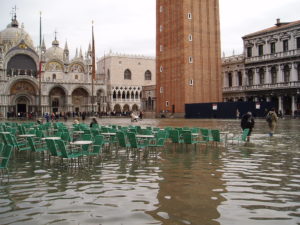Extreme flooding in Venice tests the city’s resilience
Over the past week Venice has undergone historic flooding after experiencing its highest tide in 50 years. Water has reached over six feet above sea level, covering 80 percent of the city. After three major flooding events in less than a week, the flooding has come to the second highest level ever recorded in Venice. The city is under a state of emergency and all schools are closed. Historic sites, such as St. Mark’s Square, have been overcome by the high tide, while tourism and other community functions have halted. It is estimated that the damage has reached over one billion euros so far, with the high waters continuing to persist. The city’s resilience will continue to be tested in coming years, with more frequent and extreme flooding events predicted.
With damage costs already growing, the Italian government has allocated 20 million euros to mitigate the disaster. Affected residents are eligible for 5,000 euros in initial aid, while restaurants and shop owners are eligible for up to 20,000 euros. Venice has long been prone to flooding events, however, climate change and the city’s subsidence have increased the intensity of these occurrences. While sea level continues to rise at an increasing rate and rainfall events are becoming more intense, the city also sinks one fifth of an inch per year. This combination has overcome the city, displaying a widespread lack of resilience. Residents have been told not to use the canals for transportation, and many have been forced to trek through the extremely high water. Any residents who are unable to brace the water are essentially stranded, with little solution for reaching them.

In 2003, the city began the construction of a flood-protection system costing billions of euros, however, delays and cost concerns have slowed its completion. Known as MOSE, the project includes a system of offshore dams that will protect from rising sea levels. The barriers are housed in tanks anchored to the seafloor, and are built to rise to the surface as water reaches threatening levels. While this project has the potential to protect the city in future years, more coordination is needed to get it to completion. As climate change continues to affect low-lying communities, it is predicted that as many as 200 million people worldwide will be displaced by 2050. Further resilience efforts are needed to protect Venice and its residents from becoming displaced. Other coastal cities across the globe, such as New York City and New Orleans, have proposed the construction of seawalls and levees to counteract rising sea levels. These solutions are greatly needed, and needed quickly, to build resilience throughout coastal communities.
Sources and Further Reading
Venice Flooding Brings City to ‘Its Knees’ – The New York Times
Venice closes St. Mark’s Square as floods hit for third time in week – The Guardian
Worst floods for 50 years bring Venice to ‘its knees’ – CNN
Venice Mayor is Arrested on Corruption Charges – The New York Times
A bill to establish a Global Climate Change Resilience Strategy – Congress.gov
The US cities at risk of flooding – and how they deal with it – The Guardian
